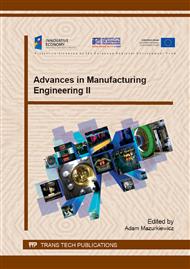[1]
P. Nagendramma, S. Kaul, Development of ecofriendly/biodegradable lubricants: An overview, Renew. Sust. Energ. Rev. 16 (2012) 764-774.
DOI: 10.1016/j.rser.2011.09.002
Google Scholar
[2]
S.C. Cermak et al., New crop oils – Properties as potential lubricants, Ind. Crop. Prod. 44 (2013) 232-239.
Google Scholar
[3]
M.A. Delgado, C. Garcīa-Rico, J.M. Franco, The use of rosemary extracts in vegetable oil-based lubricants, Ind. Crop. Prod. 62 (2014) 474-480.
DOI: 10.1016/j.indcrop.2014.09.021
Google Scholar
[4]
A. Ajanovic, Renewable fuels – A comparative assessment from economic, energetic and ecological point-of-view up to 2050 in EU-countries, Renew. Energ. 60 (2013) 733-738.
DOI: 10.1016/j.renene.2013.06.012
Google Scholar
[5]
J. Bollen, C. Brink, Air pollution policy in Europe: Quantifying the interaction with greenhouse gases and climate change polices, Energ. Econ. 46 (2014) 202-215.
DOI: 10.1016/j.eneco.2014.08.028
Google Scholar
[6]
S. Nocera, S. Tonon, F. Cavallaro, The economic impact of greenhouse gas abatement through a meta-analysis: Valuation, consequences and implications in terms of transport policy, Trans. Policy 37 (2015) 31-43.
DOI: 10.1016/j.tranpol.2014.10.004
Google Scholar
[7]
A. Campanella, E. Rustoy, A. Baldessari, M.A. Baltanás, Lubricants from chemically modified vegetable oils, Biores. Tech. 101 (2010) 245-254.
DOI: 10.1016/j.biortech.2009.08.035
Google Scholar
[8]
S. Arumugam, G. Sriram, R. Ellappan, Bio-lubricant-biodiesel combination of rapeseed oil: An experimental investigation on engine oil tribology, performance, and emission of variable compression engine, Energy 72 (2014) 618-627.
DOI: 10.1016/j.energy.2014.05.087
Google Scholar
[9]
D. Berny, Algae for biodiesel, Czysta Energia, 8 (2012) (in Polish).
Google Scholar
[10]
A. Hossain, A. Salleh, Biodiesel fuel production from algae as renewable energy, Am. J. Biochem. Biotech. 4 (2008) 250–254.
Google Scholar
[11]
M. Dębowski, M. Zieliński, A. Grala, M. Dudek, Algae biomass as an alternative substrate in biogas production. Renew. Sust. Energ. Rev. 27 (2013) 596-604.
DOI: 10.1016/j.rser.2013.07.029
Google Scholar
[12]
J. Singh, S. Gu, Commercialization potential of microalgae for biofuels production, Renew. Sust. Energ. Rev. 14 (2010) 2596-2610.
DOI: 10.1016/j.rser.2010.06.014
Google Scholar
[13]
R. Slade, A. Bauen, Micro-algae cultivation for biofuels: Cost, energy balance. Environmental impacts and future prospects, Biomass&Bioenergy 53 (2013) 29-38.
DOI: 10.1016/j.biombioe.2012.12.019
Google Scholar
[14]
P. Nautiyal, K.A. Subramanian, M.G. Dastidar, Production and characterization of biodiesel from algae, Fuel Proces. Tech. 120 (2014) 79-88.
DOI: 10.1016/j.fuproc.2013.12.003
Google Scholar
[15]
D. Mitra, J. Leeuwen, B. Lamsal, Heterotrophic/mixotrophic cultivation of oleaginous Chlorella vulgaris on industrial co-products, Algal Res. 1 (2012) 40-48.
DOI: 10.1016/j.algal.2012.03.002
Google Scholar
[16]
E. Molina, Recovery of microalgal biomass and metabolites: process options and economics. Biotech. Adv. 20 (2003) 491-515.
Google Scholar
[17]
A. Demirbas, Biodiesel from oilgae, biofixation of carbon dioxide by microalgae: A solution to pollution problems, Appl. Energ. 88 (2011) 3541-3547.
DOI: 10.1016/j.apenergy.2010.12.050
Google Scholar
[18]
W. Zhou et al., Environment-enhancing algal biofuel production using wastewaters, Renew. Sust. Energ. Rev. 36 (2014) 256-269.
Google Scholar
[19]
A. Kumar et al., Enhanced CO2 fixation and biofuel production via microalgae: recent developments and future directions, Trends in Biotech. 28 (2010) 371-380.
DOI: 10.1016/j.tibtech.2010.04.004
Google Scholar
[20]
B. Podgornik, Coated machine elements – friction or reality? Surf. Coat. Tech. 146-147 (2001) 318-323.
Google Scholar
[21]
B. Podgornik, M. Sedlaček, J. Vižintin, Compatibility of DLC coatings with formulated oils, Trib. Intern. 41 (2008) 564-570.
DOI: 10.1016/j.triboint.2007.12.004
Google Scholar
[22]
R. Michalczewski, W. Piekoszewski, M. Szczerek, W. Tuszyński, The lubricant-coating interaction in rolling and sliping contacts, Trib. Intern. 42 (2009) 554-560.
DOI: 10.1016/j.triboint.2008.05.001
Google Scholar
[23]
B. Podgornik et al., Influence of surface energy on the interactions between hard coatings and lubricants, Wear 262 (2007) 1199-1204.
DOI: 10.1016/j.wear.2006.11.008
Google Scholar
[24]
K. Dziosa, Lubricating properties of algae oil in steel-steel tribosystem, Tribologia 5 (2013) 21-31 (in Polish).
Google Scholar
[25]
M. Szczerek, W. Tuszyński, Tribological investigations. Scuffing. Institute for Sustainable Technologies, Radom, Poland, 2000 (in Polish).
Google Scholar


